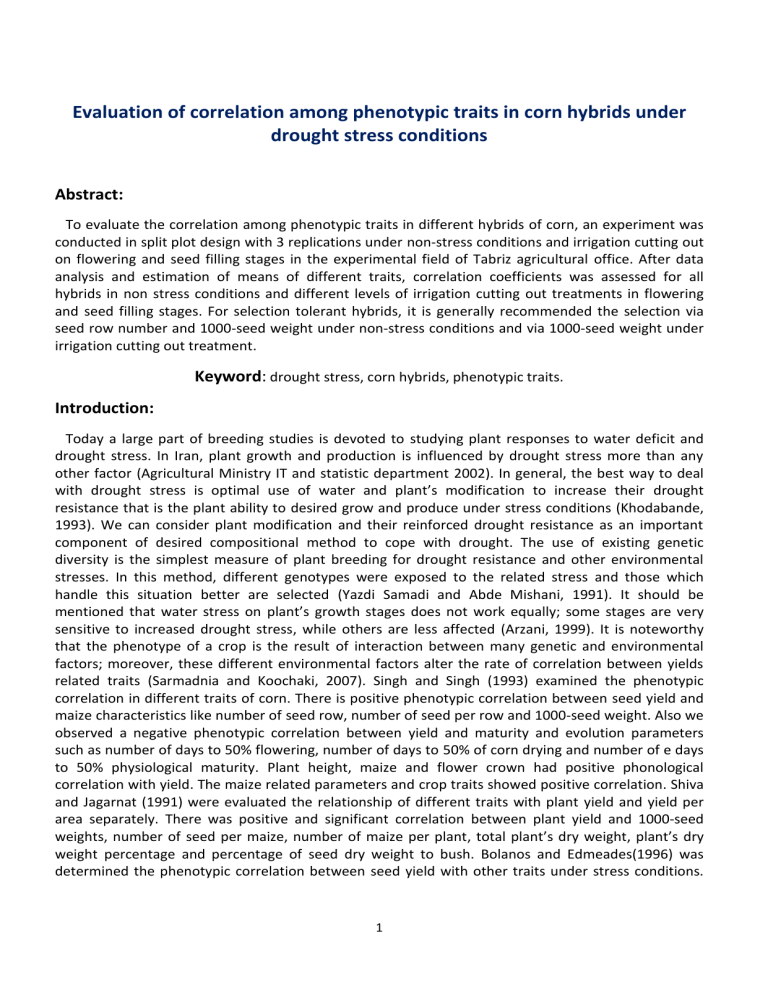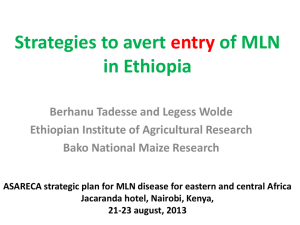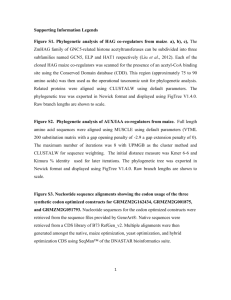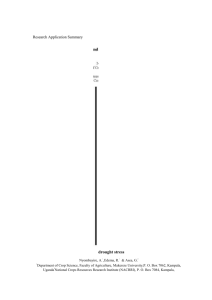Evaluation of correlation among phenotypic traits in corn hybrids

Evaluation of correlation among phenotypic traits in corn hybrids under drought stress conditions
Abstract:
To evaluate the correlation among phenotypic traits in different hybrids of corn, an experiment was conducted in split plot design with 3 replications under non-stress conditions and irrigation cutting out on flowering and seed filling stages in the experimental field of Tabriz agricultural office. After data analysis and estimation of means of different traits, correlation coefficients was assessed for all hybrids in non stress conditions and different levels of irrigation cutting out treatments in flowering and seed filling stages. For selection tolerant hybrids, it is generally recommended the selection via seed row number and 1000-seed weight under non-stress conditions and via 1000-seed weight under irrigation cutting out treatment.
Keyword:
drought stress, corn hybrids, phenotypic traits.
Introduction:
Today a large part of breeding studies is devoted to studying plant responses to water deficit and drought stress. In Iran, plant growth and production is influenced by drought stress more than any other factor (Agricultural Ministry IT and statistic department 2002). In general, the best way to deal with drought stress is optimal use of water and plant’s modification to increase their drought resistance that is the plant ability to desired grow and produce under stress conditions (Khodabande,
1993). We can consider plant modification and their reinforced drought resistance as an important component of desired compositional method to cope with drought. The use of existing genetic diversity is the simplest measure of plant breeding for drought resistance and other environmental stresses. In this method, different genotypes were exposed to the related stress and those which handle this situation better are selected (Yazdi Samadi and Abde Mishani, 1991). It should be mentioned that water stress on plant’s growth stages does not work equally; some stages are very sensitive to increased drought stress, while others are less affected (Arzani, 1999). It is noteworthy that the phenotype of a crop is the result of interaction between many genetic and environmental factors; moreover, these different environmental factors alter the rate of correlation between yields related traits (Sarmadnia and Koochaki, 2007). Singh and Singh (1993) examined the phenotypic correlation in different traits of corn. There is positive phenotypic correlation between seed yield and maize characteristics like number of seed row, number of seed per row and 1000-seed weight. Also we observed a negative phenotypic correlation between yield and maturity and evolution parameters such as number of days to 50% flowering, number of days to 50% of corn drying and number of e days to 50% physiological maturity. Plant height, maize and flower crown had positive phonological correlation with yield. The maize related parameters and crop traits showed positive correlation. Shiva and Jagarnat (1991) were evaluated the relationship of different traits with plant yield and yield per area separately. There was positive and significant correlation between plant yield and 1000-seed weights, number of seed per maize, number of maize per plant, total plant’s dry weight, plant’s dry weight percentage and percentage of seed dry weight to bush. Bolanos and Edmeades(1996) was determined the phenotypic correlation between seed yield with other traits under stress conditions.
1
Edmeades etal (1990) for studing the effects of drought stress, used the collected data during several years and found a significant correlation between seed yield and flowering period.
Methods and Materials:
In this study, ten cultivars of corn hybrids from two groups of early and medium maturity were investigated according to FAO maturity groups.
This experiment was carried out in split plot based on randomized complete block design with 3 replications in the experimental field of Tabriz agricultural office. The main factor was different levels of irrigation (completely irrigation, cutting out of irrigation at flowering and seed filling stages) and sub factor was ten cultivars from two group’s maturity. During the performance of experiment in the field, traits were measured in different levels of irrigation related to early and medium maturity. methods of analytical tools are not stated…..
Results and discussion:
Table1. The correlation coefficients of phenotypic traits in corn hybrids under non-stress conditions.
No
1 traits
Bush height
1
1
2 3 4 5 6 7 8 9
2 Maize height
3 Leave total number
6
7
8
9
10
Maize wood diameter
Seed row number
Maize length
1000- seed weight
Plant yield
0.52 1
0.164 0.701 1
4 Number of maize upper leave -0.31 0.225 0.6
5 Number of maize under leave 0.397 0.73
* 0.88*
1
0.158 1
0.332 0.73* 0.454 0.315 0.387 1
0.106 0.541 0.193 0.132 0.142 0.324 1
0.543 0.649* 0.195 -0.039 0.266 0.456 0.74* 1
-0.1 0.07 -0.3 -0.046 -0.354 0.153 0.683 0.41 1
-0.2 0.266 0.11 0.354 -0.084 0.339 0.85** 0.54 0.81** 1
10
* and **, significant in 5% and 1% , respectively.
Coefficient of phenotypic correlation of irrigation cutting out treatment at flowering stage showed that none of these studied traits had significant and positive correlation with the maize yield. The correlation of 1000-seed weight with the number of grains per row was negative and significant 5%. It means that the reinforcement of seed row in irrigation cutting out treatment has negative effect on
1000-seed weight and reduces its weight. The irrigation cutting treatment in the flowering stage makes pollen to dry and reduces pollination and fertilization and increases hollow beads percentage. So, due to increase of the number of seed row, the 1000-seed weight finally reduces.
The coefficients of phenotypic correlation in studied traits under non-stress conditions showed that the correlation of plant yield with the 1000-seed weight and the number of seed rows were positive and significant at p≥1%. The high correlation is related to the number of seed rows (r=0.855). It means that under non-stress conditions the plant yield is influenced by the number of seed rows that is so important. None of the traits had significant positive or negative correlation with 1000-seed weight.
The correlation of the number of the seed row with the maize length and height and the number of the leaf under maize was positive and significant 5%. So we found that under non-stress conditions, the yield is influenced by the number of the seed row and 1000-seed weight and those are appropriate traits for the maize yield.
2
Table2. The correlation coefficients of phenotypic traits in corn hybrids in flowering stage and irrigation cutting treatment.
No traits
1 Bush height
1
1
2 3 4
2 Maize height
3 Leave total number
0.23
4 Number of maize upper leave 0.44
1
0.134 0.613 1
-0.179 0.214 1
5 6 7 8 9
5 Number of maize under leave 0.177 0.67* 0.75* -0.483 1
6 Maize wood diameter 0.71
* 0.332 0.36 0.166 0.211 1
7 Seed row number 0.069 0.044 0.001 0.008 -0.004 0.202 1
8 Maize length
9 1000 -seed weight
10 Plant yield
0.225 0.519 0.132 -0.459 0.428 0.69 0.286 1
-0.122 -0.299 -0.338 0.213 -0.447 -0.583 -0.374 -0.581 1
-0.199 -0.298 -0.406 -0.172 -0.248 -0.403 0.344 -0.132 0.581 1
10
* and **, significant in 5% and 1% , respectively.
Coefficient of phenotypic correlation of irrigation cutting out treatment at seed filling stage showed that the correlation of maize yield with the traits like the maize wood diameter and 1000-seed weight was positive and significant and the high correlation is related to the maize wood diameter (0.814). It means that under irrigation cutting treatment, the yield is influenced by this trait and it is more important than 1000-seed weight. So we can claim that according the results, irrigation cutting out treatment at the seed filling stage by affecting on leaf photosynthesis causes reduction the material transportation to the seed, so it finally reduces the yield under non-stress conditions. We conclude that it is possible to select hybrids for resistance to drought stress based on maize wood diameter and
1000-seed weight traits under irrigation cutting treatment in seed filling stage.
Table3. The correlation coefficients of phenotypic traits in corn hybrids in irrigation cutting treatment, in flowering stage.
No traits 1 2 3 4 5 6 7 8 9 10
1 Bush height
2 Maize height
1
0.70* 1
3 Leave total number 0.67* 0.619 1
4 Number of maize upper leave 0.433 0.09 0.69* 1
5 Number of maize under leave 0.63* 0.76* 0.90** 0.308 1
6 Maize wood diameter 0.467 0.548 0.135 -0.074 0.22 1
7 seed row number 0.524 0.332 0.054 0.074 0.03 0.38 1
8 Maize length
9 1000- seed weight
10 Plant yield
0.46 0.421 0.168 -0.105 0.29 0.17 0.84 1
-0.217 -0.113 -0.054 -0.275 0.08 0.35 -0.25 -0.07 1
0.352 0.318 0.054 -0.159 0.16 0.81* 0.41 0.38 0.66 1
* and **, significant in 5% and 1% , respectively.
References
1.
Agricultural Ministry IT and statistic department, 2002,
2.
Arzani A 1999, plants improvement (translation), forth volume, Isfahan industrial university publication
3
3.
Bolanos J and Edmeades GO 1996. Midseason drought as a selection environment for tropical maize improvement . In developing drought and low nitrogen tolerant Maize . 1996 . D.F. Mexico.
CIMMYT
4.
Edmeades G, Bolanos J and Laffitte HR 1990.Selection for drought tolerance in maize adapted to the lowland tropics,CIMMYT.Mexico.D.F.
5.
Khodabande N 1993. cereal, third print, Tehran university publication
6.
Sarmadnia GH and Koochaki A 2007. physiological planting, second volume, Mashhad University
7.
Shiva S and Jagarnath MK 1991. Relationship of the growth and yield component with grain yield of maize through path analysis. J.Agric.Res.42:223-225.
8.
Singh G and singh M 1993.Correlation and path analysis in maize under mild - hills of skin. Crop
Improvement .20:222-227.
9.
Yazdi Samadi B and Abde Mishani S 1991. plants improvement, university publications.
4







